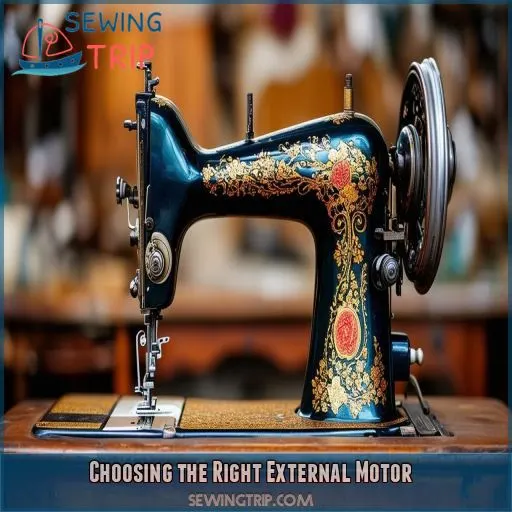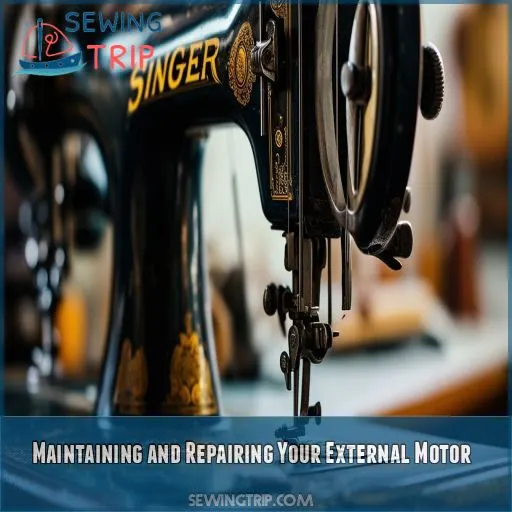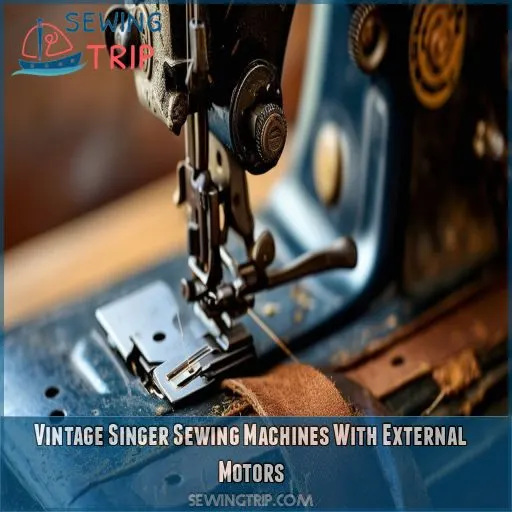This site is supported by our readers. We may earn a commission, at no cost to you, if you purchase through links.
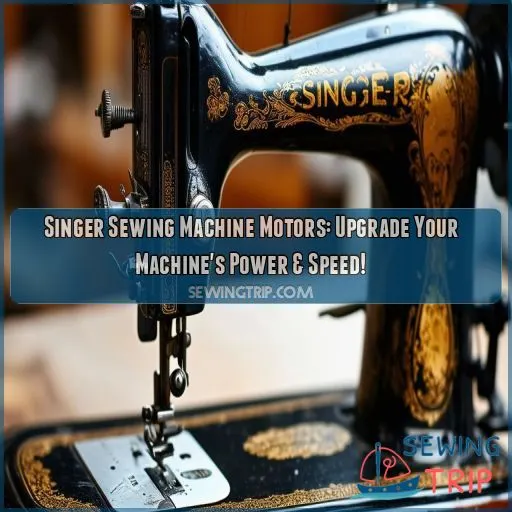 Singer sewing machines are often prized possessions, and finding an external motor to breathe new life into an old machine can be a challenge. Singer sewing machines with external motors are available on sites like eBay and Amazon.
Singer sewing machines are often prized possessions, and finding an external motor to breathe new life into an old machine can be a challenge. Singer sewing machines with external motors are available on sites like eBay and Amazon.
Singer Motor Model HF-06150, found on eBay, includes a light and foot pedal. Amazon offers a powerful little motor that’s easy to install, with one reviewer noting it was a great replacement for their old Singer.
If you’re looking to upgrade or repair your Singer, read on for more insights.
Table Of Contents
Key Takeaways
- Singer sewing machines with external motors offer a power boost, speed control, and quiet operation, making them a great choice for sewing enthusiasts, especially those working with heavy-duty fabrics.
- You can find external motors for your Singer machine on sites like eBay and Amazon, with options for various models and preferences.
- If you’re feeling handy, installing an external motor yourself is possible with the right tools and a bit of guidance. It’s important to unplug your machine and refer to a guide or manual for a safe and successful installation.
- Troubleshooting common issues with your external motor can be done by checking for things like loose parts, adequate power sources, and worn-out components. Regular maintenance and cleaning are also key to keeping your machine humming smoothly.
Singer Sewing Machine With External Motor

Singer sewing machines with external motors offer a unique set of advantages, from easy installation to enhanced performance. In this section, we’ll explore the benefits of external motors, guide you through the installation process, and provide troubleshooting tips for common issues.
Benefits of Using an External Motor
The benefits of using an external motor with your Singer sewing machine are clear.
First, you get a serious power boost, making sewing heavy-duty fabrics a breeze. Say goodbye to frustrating stalls and uneven stitches.
Next up, speed control. An external motor lets you easily adjust the speed, giving you more control over your sewing projects.
Plus, you’ll love the quiet operation – no more noisy distractions while you work.
And if you’re a vintage machine enthusiast, an external motor can be a game-changer, adding modern functionality to your beloved classic.
How to Install an External Motor
If you’re feeling handy and want to install an external motor on your Singer sewing machine, here’s a quick guide to get you started:
- Unplug Your Machine: Before you begin, always remember to unplug your sewing machine from the power source. Safety first!
- Gather Your Tools: You’ll need a few basic tools like a screwdriver, wrench, and possibly a pair of pliers.
- Remove the Old Motor: Loosen the screws and carefully detach the old motor from the machine. Take note of how it’s attached so you can replicate the setup with the new motor.
- Install the New Motor: Align the new motor with the mounting bracket and secure it in place with the screws. Make sure it’s firmly attached and won’t shift during use.
Now, you’re ready to plug in your machine and test out that new motor!
Troubleshooting Common Issues
- Noise and Vibration: If your machine is making strange noises or vibrating excessively, check the motor belt. Over time, belts can stretch and slip, causing these issues. Try adjusting the belt tension or replacing the belt entirely for a quick fix.
- Speed Issues: Is your machine sewing at an uneven speed or struggling to keep up? It could be a problem with the motor’s power supply or carbon brushes. Check for any loose connections or worn-out brushes and replace them if necessary.
- Needle Problems: If your needle is breaking or bending, it might be time for a new one. Make sure you’re using the right needle type and size for your project.
Top 7 Singer Sewing Machine Motors
If you’re in the market for a new motor for your Singer sewing machine, you’re in luck. We’ve rounded up the top seven Singer sewing machine motors on the market, so you can find the perfect one for your needs. From heavy-duty options to rubber belts, we’ll help you find the best buy for your machine.
1. HimaPro Sewing Machine Motor Kit
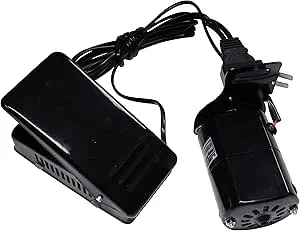
The HimaPro Sewing Machine Motor Kit is a versatile option, compatible with a wide range of Singer and Pfaff models. This 100W motor packs a punch with a 6000 RPM heavy-duty motor and L-shaped bracket mount. It comes with a foot controller, belt, bolts, and carbon brush. While some users reported issues with speed, sensitivity, and quality control, others were satisfied with its performance. With a 30-day money-back guarantee, you can test it risk-free.
Best For: The HimaPro Sewing Machine Motor Kit is best for those looking to upgrade their Singer or Pfaff sewing machine with a powerful and compatible motor.
- Powerful 6000 RPM motor: Provides plenty of sewing speed for most projects.
- Wide compatibility: Works with a wide range of Singer and Pfaff models.
- 30-day money-back guarantee: Lets you try it out risk-free.
- Potential speed issues: Might be too fast for some vintage sewing machines.
- Quality control inconsistencies: Some users have reported issues with faulty wiring or components.
- Foot pedal sensitivity concerns: Some users have experienced issues with the foot pedal’s sensitivity and responsiveness.
2. Sewing Machine Motor Kit 110 Volt
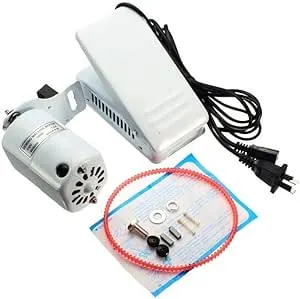
If you’re after a versatile motor, the Sewing Machine Motor Kit 110 Volt is a great choice. It’s designed to fit most older Singer models, like the 15, 66, 99, and more. With a sturdy L-bracket mount and heavy-duty construction, this motor means business. It rotates counterclockwise, the standard for most sewing machines, and has a speed of 6000 RPM. The kit comes with the motor, controller, manual, and accessories, giving you everything you need to get started. Reviews mention its strength and ease of use, but some users wish the pedal cord was longer.
Best For: This motor is best for owners of older Singer machines who need a reliable replacement.
- Sturdy L-bracket mount for secure installation.
- Heavy-duty construction for long-lasting performance.
- Easy to use and install.
- Short pedal cord.
- May not be compatible with all sewing machines.
- Some users reported issues with the controller.
3. Sewing Machine Motor Pedal and Light
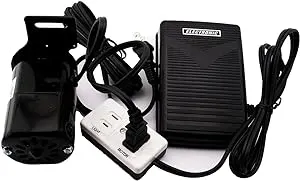
If you’re after a motor, pedal, and light setup, this could be a good option. This heavy-duty, high-speed K-bracket motor comes with a pedal and block for the motor and light. It’s compatible with most older machines, including Singer HA-1, 15, 66, 99, and 99K class machines. The motor specs include 110 volts, 7000 RPM, 50/60Hz, 90 watts, and 0.9 amps, and it runs counterclockwise.
The reviews are mixed. While some users found the motor a little underpowered, many were happy with the improvement over their old motors. Some users also needed to replace the included belt with a longer one.
Best For: This motor is best for those looking to upgrade their older Singer sewing machine with a heavy-duty, high-speed motor and a convenient pedal and light setup.
- Heavy-duty motor with high speed for faster sewing.
- Includes pedal and block for motor and light for a convenient and safe power solution.
- Compatible with a wide range of older Singer sewing machines.
- Some users found the motor to be slightly underpowered.
- The included belt may be too short and need to be replaced.
- The instructions may be unclear about oiling port location.
4. Singer Sewing Machine Motor Pedal
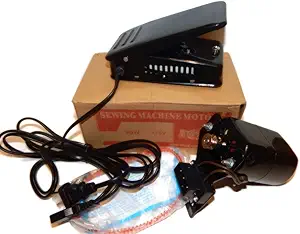
This motor’s a powerhouse, with a 0.9 amp motor that fits older Singer models like the 15, 66, 99, and 99k. It’s a versatile option, even for spooling fishing line. While it’s well-built and easy to install, the foot pedal can get hot, and the motor may overheat quickly. It offers variable speed control, but the wires are thin and the quality is questionable. Overall, it’s a cost-effective option for reviving older machines, but there are more reliable choices if you need something long-lasting.
Best For: Those looking for a budget-friendly option to revive older Singer sewing machines.
- Offers variable speed control.
- Easy to install.
- Well-built with good performance.
- Foot pedal can get hot.
- Wires are thin and may be poorly constructed.
- Motor can overheat quickly.
5. Singer Heavy Duty Sewing Machine
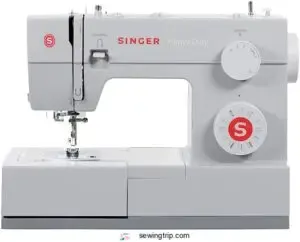
If you’re tired of your sewing machine acting up, the Singer Heavy Duty 4423 Sewing Machine is the reliable workhorse you need. It’s a far cry from those fancy, over-complicated machines with features you’ll never use. This machine is built to last with its heavy-duty metal frame and powerful motor, ready to tackle any project you throw at it.
One of the best features is its easy threading. No more struggling with tiny needles! The automatic needle threader makes it a breeze for beginners and pros alike. Plus, you won’t have to worry about frustrating tension issues thanks to its reliable thread tension system.
With 23 stitches, you’ve got a variety of options for all kinds of projects. And the top drop-in bobbin lets you keep an eye on your bobbin thread, so you’re never caught off guard. The LED light illuminates your work area, so you can sew with precision.
Some users have had issues with bobbin jams and thread tension, but the secret is in the setup. Use the right plastic bobbins, follow the threading guide carefully, and take your time with the foot control. Once you’ve got it dialed in, you’ll be sewing like a pro!
Best For: The Singer Heavy Duty 4423 Sewing Machine is best for beginners, experienced sewers, and anyone looking for a reliable machine that can handle a variety of projects.
- Built to last with a heavy-duty metal frame and powerful motor
- Easy to thread with an automatic needle threader
- Reliable thread tension system for smooth, consistent stitches
- Bobbin jams can occur if the setup isn’t done correctly
- Some users have reported issues with thread tension, but these can be resolved with proper setup
- The foot control can be powerful, so it may take some time to get used to
6. Sewing Machine Rubber Belts 4 Pack
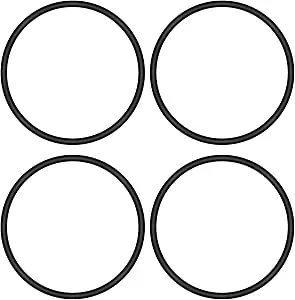
If your sewing machine’s rubber belt is worn out, it’s time for a replacement. The Sewing Machine Rubber Belts 4 Pack offers a cost-effective solution with its set of four nitrile rubber belts, each measuring 33cm in circumference and 0.5cm in diameter. These belts are compatible with most external motor sewing machines, including Singer and other household brands. Before purchasing, make sure your current belt measures 33cm, and double-check your machine’s motor type to make sure it’s a good fit. Keep your sewing machine running smoothly with this essential accessory.
Best For: Home sewers with external motor sewing machines needing a replacement belt.
- Cost-effective 4-pack
- Compatible with popular brands like Singer
- Made of durable nitrile rubber
- Ensure correct size and motor type before purchasing
- May not be compatible with all sewing machines
- Not a high-end, premium brand
7. Sewing Machine Motor Foot Pedal Set
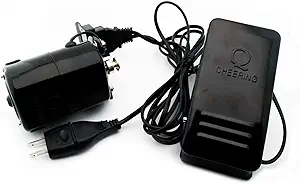
If you’re looking for a motor foot pedal set that’s compatible with a range of older Singer sewing machines, the Cutex Domestic Sewing Machine Motor & Foot Control Pedal Set is a great option. It fits a bunch of Singer models, including the 15, 66, 99, 185, 285, 293B, and more. It’s also compatible with most Japanese machines with external motors. Installation is a breeze, and the set comes with a new belt and extra motor brushes. With 110 volts, 6000 RPM, and 100 watts, this motor packs a punch.
Best For: The Cutex Domestic Sewing Machine Motor & Foot Control Pedal Set is best for those with older Singer sewing machines or Japanese machines with external motors who need a powerful and reliable motor.
- Easy installation
- Powerful motor capable of sewing through multiple layers of denim
- Includes a new belt and extra motor brushes
- Not variable speed
- May not be suitable for all sewing needs
- Some customers reported issues with the motor
Choosing the Right External Motor
Choosing the right external motor for your Singer sewing machine is important for getting the best performance. We’ll walk you through the things to keep in mind, from understanding motor power and speed to comparing different brands and models, so you can make a smart choice.
Factors to Consider When Selecting a Motor
When choosing the right external motor for your Singer sewing machine, there are a few things to keep in mind.
First, think about the type of projects you’ll be tackling. If you’re a hobbyist who sews light fabrics, a standard motor will do. But if you’re a heavy-duty user sewing through thick materials, you’ll need a more powerful motor that can handle the extra strain.
Next, consider the speed you want to sew at. If you’re a speed demon, look for a motor with extra-high sewing speed. But if you prefer a slower, more deliberate pace, a standard motor will be just fine.
Don’t forget about noise and size! Some motors are quieter and more compact than others. If you have limited space or prefer a peaceful sewing session, keep an eye out for motors that fit the bill.
Understanding Motor Power and Speed
When choosing an external motor, understanding motor power and speed is really important. Here’s a quick guide:
- Motor Power: Measured in watts, it determines the motor’s strength. Higher wattage means more power, which is essential for heavy-duty sewing projects.
- RPM (Revolutions Per Minute): This indicates the motor’s speed, or how fast it can sew. A higher RPM means faster stitching, but it’s not always better—slower speeds are ideal for precision work.
- Torque: This measures the motor’s force, or its ability to overcome resistance. A motor with higher torque can handle thicker fabrics and multiple layers with ease.
- Speed Control: Look for motors with adjustable speed settings. This lets you easily switch between high-speed stitching and slower, more precise work.
Choosing the right motor power and speed will make sure your Singer sewing machine can handle any project, from delicate fabrics to heavy-duty materials.
Comparing Different Motor Brands and Models
Picking the right external motor for your Singer sewing machine is a big deal. Here’s what to think about:
First, check out the different motor brands and models out there. Each one has its own features and specs that are good for different things. Pay attention to things like how powerful the motor is, how fast it goes, and how much torque it has. You want a motor that can handle whatever you’re sewing.
It’s also important to think about what your sewing machine needs. For example, if you have a heavy-duty Singer, you’ll need a motor that’s strong enough to sew through thick fabrics. If you have a lighter machine, a motor that’s not as fast might be better.
And don’t forget about what you like, too. Some motors have features that might work better for your sewing style or experience level. For example, you might like a motor with adjustable speed settings, so you can control your sewing better.
Maintaining and Repairing Your External Motor
Maintaining your external motor is essential to keep your Singer sewing machine humming along smoothly. We’ll guide you through the ins and outs of regular maintenance, troubleshooting common issues, and knowing when to call in the pros for repairs.
Regular Maintenance and Cleaning
Keeping your Singer sewing machine running smoothly is important to make sure it keeps sewing beautifully. Here are a few tips to help you keep it in top shape:
- Regular Cleaning: Keep your machine clean and well-maintained. Use a soft, dry cloth to wipe down the exterior and a small brush to gently remove any dust or debris from hard-to-reach areas.
- Lubrication: Don’t forget to lubricate moving parts with sewing machine oil to help keep things running smoothly and prevent wear and tear.
- Machine Manuals: Refer to your Singer sewing machine manual for specific instructions on maintenance, including lubrication and cleaning recommendations.
- Warranty Information: Before attempting any repairs, check your warranty information. Singer provides troubleshooting tips and support for common issues, empowering you to identify and fix minor problems yourself.
Identifying and Replacing Worn Parts
Keeping your Singer sewing machine running smoothly is important for its performance and lifespan. Here’s a quick guide to help you keep your machine in tip-top shape:
Signs of Wear and Tear
| Part | Signs of Wear | Impact on Performance |
|---|---|---|
| Belts | Cracks, fraying, or stretching | Reduced power transmission, uneven stitching |
| Needles | Bends, dullness, or breakage | Damaged fabric, uneven stitches, thread tangles |
| Bobbins | Excessive vibration, thread tangles | Uneven stitches, thread breakage |
| Motor Brushes | Excessive sparking, burnt smell | Reduced motor power, potential motor failure |
| Foot Pedal | Reduced responsiveness, sticking | Inconsistent speed control |
Regularly inspect these parts and replace them as needed to make sure your machine runs smoothly and efficiently.
Troubleshooting Common Motor Issues
Troubleshooting common motor issues is a key part of keeping your external motor running smoothly. Here are some tips to help you figure out and fix problems:
- Noise: If your motor is making unusual noises, check for loose parts or debris caught in the mechanism.
- Speed: If the motor is running slower than usual, make sure the power source is adequate and there’s no friction slowing it down.
- Heat: A hot motor could mean there’s a problem with the bearings or brushes. Check for wear and replace if needed.
- Vibration: Excessive vibration can be caused by unbalanced parts or a faulty power supply.
Professional Repair and Maintenance Options
When your Singer sewing machine motor starts acting up, it’s time to bring in the pros. Why? Well, for starters, they’ve got the know-how to tackle even the trickiest motor issues. Plus, they’ve got those fancy specialized tools that you mightn’t have lying around at home. And let’s not forget the peace of mind that comes with a warranty-protected repair.
So, where do you find these miracle workers? Start by checking out local sewing machine shops—they often have technicians who are experts in Singer machines. You can also try an online search for reputable repair services in your area or head straight to Singer’s website for a list of authorized repair centers.
Once you’ve found your technician, here’s what to expect: they’ll give your motor a thorough inspection, diagnose the problem, perform any necessary repairs or adjustments, and then test it to make sure it’s running like new.
To keep your motor happy and healthy between professional tune-ups, don’t forget to show it some love with regular cleaning, lubrication, and inspections.
Vintage Singer Sewing Machines With External Motors
If you’re into vintage finds, you’re in for a treat. We’ll explore the world of vintage Singer sewing machines with external motors. From their history to collecting and restoring these timeless pieces, we’ll explore the ins and outs of these machines.
The History of Singer Sewing Machines
Singer sewing machines have a rich history, dating back to the 19th century.
The company was founded in 1851 and quickly gained popularity for its durable and reliable machines.
Singer was the first company to sell sewing machines on installments, making them accessible to a wider range of people.
With its innovative sales strategy and diverse range of models, Singer became a global brand, known from the USA to Russia.
They introduced the first electrical sewing machine and the first computerized sewing machine, the Quantum XL-1000.
Collecting and Restoring Vintage Machines
Collecting vintage Singer sewing machines is a fun hobby, and restoring them is a rewarding project.
These old machines have a unique charm and history, and with some TLC, they can be upcycled into something new.
When collecting, research is key.
Learn about the models and their specifications to find the right fit for your needs and budget.
Check functionality, condition, and age, and don’t be afraid to seek expert advice.
Upgrading Vintage Machines With External Motors
Upgrading your vintage Singer sewing machine with an external motor is a great way to give it new life and improve its performance.
External motors offer several benefits, including increased power and speed, which can make sewing thicker fabrics or tackling more complex projects a breeze. They’re also a fantastic option if you’re looking to reduce noise levels, as they can provide a quieter sewing experience compared to older, built-in motors.
When choosing an external motor for your vintage machine, consider factors such as motor power, speed, and noise levels to make sure it fits your specific sewing needs.
Tips for Using Vintage Machines With External Motors
Using a vintage Singer sewing machine with an external motor is a breeze if you keep a few things in mind.
First, make sure you’ve got the right motor for the job – these machines pack a punch, so go for a sturdy metal frame and a powerful motor.
Next, leather requires longer stitches, so adjust your stitch length accordingly.
You’ll also want to be able to control the fabric feed, so look for a machine with adjustable presser foot pressure. A walking foot is a must-have for even fabric feeding.
Finally, use the right needles and thread for the job – leather needles and thread are stronger and designed specifically for sewing leather.
With these tips, you’ll be sewing like a pro in no time!
Frequently Asked Questions (FAQs)
What is a potted motor on a Singer sewing machine?
A potted motor is a direct gear drive motor attached to the back of a Singer sewing machine. It’s a more durable and high-performance option than belt-driven motors.
Are very old Singer sewing machines worth anything?
Sure, some vintage Singer sewing machines can be worth a pretty penny, but it depends on their condition, functionality, and market availability. So, don’t stash away that old machine just yet—it might be worth a small fortune!
What is a servo sewing machine motor?
A servo sewing machine motor is an efficient, precise, and silent motor. It’s equipped with a magnetic steel sleeve and needle bearing, improving the motor’s service life and reducing maintenance costs.
How much is a Singer 15 88 worth?
I couldn’t find a clear answer for how much a Singer 15-88 is worth, but I did find a few sources that might be helpful. One source mentions a donation of a Singer Sewing Machine 15-88 and 15-89 for an auction, and another source mentions a few Singer 15-88 products and their prices.
How much do vintage Singer machines cost?
Vintage Singer machines vary in price. Most sell for $50 to $500, but rare models can go for over $2, The Singer 201 in working condition costs between $305 and $
What are the benefits of a vintage machine?
Vintage sewing machines are built to last. They’re made with durable metal parts, so they’re less likely to break and cheaper to repair. They’re also beginner-friendly, can handle heavyweight fabrics, and will still be going strong in 20+ years.
How do I find a vintage Singer machine?
You can find vintage Singer sewing machines on eBay, Craigslist, antique stores, sewing machine repair shops, local flea markets, and garage sales. Online, Sandman Collectibles has an identification guide to help you find your model.
How do I maintain a vintage Singer machine?
Maintaining your vintage Singer is a breeze with these tips: oil moving parts and holes, use a soft cloth for dust, and cotton balls with sewing machine oil for cleaning. Check the manual for model-specific advice.
Can I use a Singer machine for leatherworking?
Yes, but it depends on the model and the thickness of the leather. You’ll need a leather-specific or walking foot machine for thicker leather. You’ll also need a leather needle and thread.
Conclusion
You’re now armed with a treasure trove of knowledge about Singer sewing machine motors and some nifty tricks up your sleeve.
With this guide, finding the best external motor for your beloved Singer is a breeze, and you can give your old machine a new lease of life.
Now, go forth and sew like the wind!

